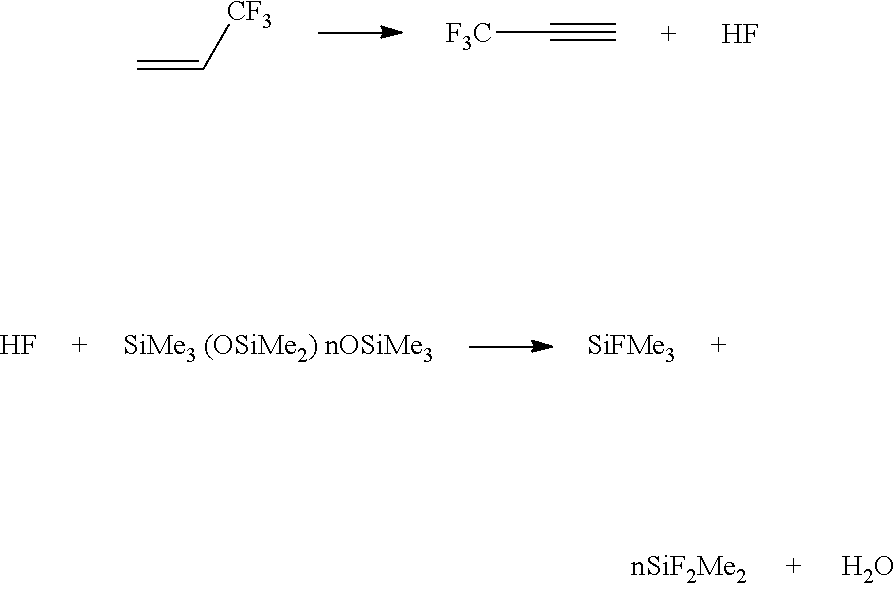Stabilized hydrochlorofluoroolefins and hydrofluoroolefins
a technology of hydrofluoroolefin and hydrochlorofluoroolefin, which is applied in the direction of detergent compounding agents, fire extinguishers, other chemical processes, etc., can solve the problems of low energy efficiency, flammability, and/or affecting the commercial application of such materials, and achieve the effect of reducing the degradation level
- Summary
- Abstract
- Description
- Claims
- Application Information
AI Technical Summary
Benefits of technology
Problems solved by technology
Method used
Image
Examples
examples 1-4
Stability of 1234ze, 1.233zd, 1243zf and F1233xf as a Blowing Agent in PUR Formulation
[0049]Foam was made by small polyurethane dispenser consisting of two pressurized cylinders, one for the A side methylene diphenyl diisocyanate (MDI) and one for the B side (polyol mixtures). The pressure in the cylinders could be adjusted by regulators. The B-side mixtures were pre-blended and then charged into the pressurized cylinders. The blowing agents were then added into B-side cylinder and mixed thoroughly. The cylinders were connected to a dispensing gun equipped with a static mixer. The pressures of both cylinders were adjusted so that desired ratio of the A and B sides could be achieved. The formulations tested (all had an Iso Index of 110) contained Rubinate M, a polymeric methylene diphenyl diisocyanate (MDI) available from Huntsman; Jeffol SG-360 and R-425-X, polyols from Huntsman; TEAP-265, a polyol from Carpenter Company; Tegostab B 8465 a surfactant available from Evonik-Degussa; J...
example 5
Stability of 1234ze in PUR Foam
[0056]Example 2 could be repeated with the addition of 200 ppm of the various stabilizers listed in Table 3 to the B side formulation and HFO 1234ze used as a foam blowing agent. Table 3 summarizes the expected formation of the silane co-products, which would evidence the degradation of the 1234ze.
[0057]
TABLE 3Effect of Stabilizers on PUR Foamand HFO 1234ze Blowing AgentStabilizer (200 ppm)Silane Co-Products (ppm)None 2500α-methylstyreneNitromethane1,2-epoxybutaneGlycidyl methyl etherisoprene
[0058]The data would be expected to show that the level of degradation was substantially decreased from 2500 ppm of SiF2Me2 and SiFMe3 to much less than 100 ppm of the silane compounds.
example 6-7
Stability of 1243zf and 1234ze in Polystyrene Foam (XPS)
[0059]The stability of these blowing agents was investigated in an autoclave in the presence of polystyrene beads and other additives which mimic: the process of making XPS foam.
[0060]To an autoclave was added: general purpose polystyrene resin (MFI=11.0 g / 10 min), talc concentrate (50% talc in polystyrene), water and flame retardant (tris(2-chloroethyl)phosphate). The autoclave was then sealed and loaded with the hydrofluoroolefin to be tested. One “blank” was run with no hydrofluoroolefin addition and overpressured to 30 psig with nitrogen to permit sampling of the vapor space following aging. Table 4 summarizes the formulations tested using 1243zf (example 6) and 1234ze (example 7) as blowing agents. The vapor phase in the autoclave was analyzed via gas chromatograph after aging for 24 hours at 140° C. Table 5 summarizes the results of the aging testing.
[0061]
TABLE 4Formulations of the HFO 1234zf and 1234ze in XPS1Poly-Flame...
PUM
| Property | Measurement | Unit |
|---|---|---|
| GWP | aaaaa | aaaaa |
| temperatures | aaaaa | aaaaa |
| glass transition temperature | aaaaa | aaaaa |
Abstract
Description
Claims
Application Information
 Login to View More
Login to View More - R&D
- Intellectual Property
- Life Sciences
- Materials
- Tech Scout
- Unparalleled Data Quality
- Higher Quality Content
- 60% Fewer Hallucinations
Browse by: Latest US Patents, China's latest patents, Technical Efficacy Thesaurus, Application Domain, Technology Topic, Popular Technical Reports.
© 2025 PatSnap. All rights reserved.Legal|Privacy policy|Modern Slavery Act Transparency Statement|Sitemap|About US| Contact US: help@patsnap.com

